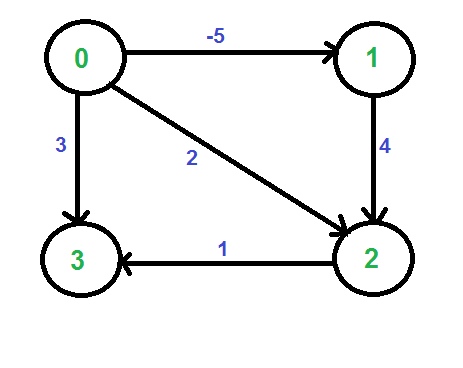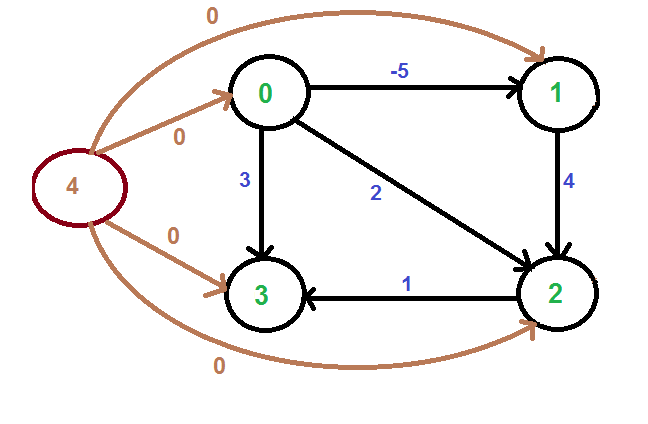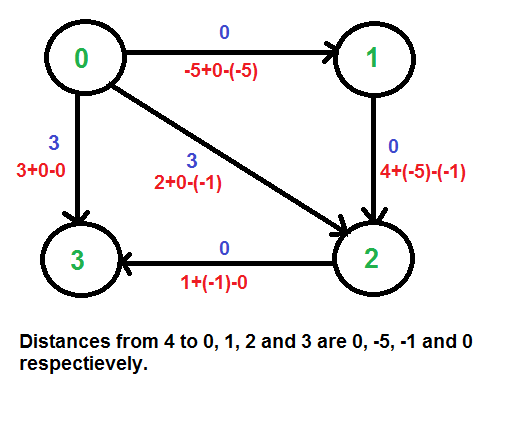给定一个权重可能为负的加权有向图,请使用约翰逊算法在图中的每对顶点之间找到最短路径。
约翰逊算法的详细解释已经在之前的文章中讨论过了。
请参阅:All-pairs最短路径的Johnson算法。
这篇文章着重于约翰逊算法的实现。
算法:
- 假设给定的图为G。向图添加一个新的顶点s,将新顶点的边添加到G的所有顶点。让修改后的图为G’。
- 在s为源的G’上运行Bellman-Ford算法。令由Bellman-Ford计算的距离为h [0],h [1],.. h [V-1]。如果发现负重循环,则返回。请注意,负权重循环无法由新顶点s创建,因为s没有边。所有边均来自。
- 重新加权原始图形的边缘。对于每个边缘(u,v),将新权重分配为“原始权重+ h [u] – h [v]”。
- 删除添加的顶点,并为每个顶点运行Dijkstra的算法。
例子:
让我们考虑下图。

我们添加一个source,并将s的边添加到原始图的所有顶点。在下图中,s为4。

我们使用Bellman-Ford算法计算从4到所有其他顶点的最短距离。从4到0、1、2和3的最短距离分别为0,-5,-1和0,即h [] = {0,-5,-1、0}。一旦获得这些距离,我们将删除源顶点4并使用以下公式对边缘进行加权。 w(u,v)= w(u,v)+ h [u] – h [v]。

由于现在所有权重都为正,因此我们可以对每个顶点作为源运行Dijkstra的最短路径算法。
下面是上述方法的实现
# Implementation of Johnson's algorithm in Python3
# Import function to initialize the dictionary
from collections import defaultdict
MAX_INT = float('Inf')
# Returns the vertex with minimum
# distance from the source
def minDistance(dist, visited):
(minimum, minVertex) = (MAX_INT, 0)
for vertex in range(len(dist)):
if minimum > dist[vertex] and visited[vertex] == False:
(minimum, minVertex) = (dist[vertex], vertex)
return minVertex
# Dijkstra Algorithm for Modified
# Graph (removing negative weights)
def Dijkstra(graph, modifiedGraph, src):
# Number of vertices in the graph
num_vertices = len(graph)
# Dictionary to check if given vertex is
# already included in the shortest path tree
sptSet = defaultdict(lambda : False)
# Shortest distance of all vertices from the source
dist = [MAX_INT] * num_vertices
dist[src] = 0
for count in range(num_vertices):
# The current vertex which is at min Distance
# from the source and not yet included in the
# shortest path tree
curVertex = minDistance(dist, sptSet)
sptSet[curVertex] = True
for vertex in range(num_vertices):
if ((sptSet[vertex] == False) and
(dist[vertex] > (dist[curVertex] +
modifiedGraph[curVertex][vertex])) and
(graph[curVertex][vertex] != 0)):
dist[vertex] = (dist[curVertex] +
modifiedGraph[curVertex][vertex]);
# Print the Shortest distance from the source
for vertex in range(num_vertices):
print ('Vertex ' + str(vertex) + ': ' + str(dist[vertex]))
# Function to calculate shortest distances from source
# to all other vertices using Bellman-Ford algorithm
def BellmanFord(edges, graph, num_vertices):
# Add a source s and calculate its min
# distance from every other node
dist = [MAX_INT] * (num_vertices + 1)
dist[num_vertices] = 0
for i in range(num_vertices):
edges.append([num_vertices, i, 0])
for i in range(num_vertices):
for (src, des, weight) in edges:
if((dist[src] != MAX_INT) and
(dist[src] + weight < dist[des])):
dist[des] = dist[src] + weight
# Don't send the value for the source added
return dist[0:num_vertices]
# Function to implement Johnson Algorithm
def JohnsonAlgorithm(graph):
edges = []
# Create a list of edges for Bellman-Ford Algorithm
for i in range(len(graph)):
for j in range(len(graph[i])):
if graph[i][j] != 0:
edges.append([i, j, graph[i][j]])
# Weights used to modify the original weights
modifyWeights = BellmanFord(edges, graph, len(graph))
modifiedGraph = [[0 for x in range(len(graph))] for y in
range(len(graph))]
# Modify the weights to get rid of negative weights
for i in range(len(graph)):
for j in range(len(graph[i])):
if graph[i][j] != 0:
modifiedGraph[i][j] = (graph[i][j] +
modifyWeights[i] - modifyWeights[j]);
print ('Modified Graph: ' + str(modifiedGraph))
# Run Dijkstra for every vertex as source one by one
for src in range(len(graph)):
print ('\nShortest Distance with vertex ' +
str(src) + ' as the source:\n')
Dijkstra(graph, modifiedGraph, src)
# Driver Code
graph = [[0, -5, 2, 3],
[0, 0, 4, 0],
[0, 0, 0, 1],
[0, 0, 0, 0]]
JohnsonAlgorithm(graph)
输出:
Modified Graph: [[0, 0, 3, 3], [0, 0, 0, 0], [0, 0, 0, 0], [0, 0, 0, 0]]
Shortest Distance with vertex 0 as the source:
Vertex 0: 0
Vertex 1: 0
Vertex 2: 0
Vertex 3: 0
Shortest Distance with vertex 1 as the source:
Vertex 0: inf
Vertex 1: 0
Vertex 2: 0
Vertex 3: 0
Shortest Distance with vertex 2 as the source:
Vertex 0: inf
Vertex 1: inf
Vertex 2: 0
Vertex 3: 0
Shortest Distance with vertex 3 as the source:
Vertex 0: inf
Vertex 1: inf
Vertex 2: inf
Vertex 3: 0
时间复杂度:以上算法的时间复杂度为![]() 正如Dijkstra的算法所需要的
正如Dijkstra的算法所需要的![]() 用于邻接矩阵。注意,通过使用邻接表代替邻接矩阵来表示图,可以使上述算法更加有效。
用于邻接矩阵。注意,通过使用邻接表代替邻接矩阵来表示图,可以使上述算法更加有效。